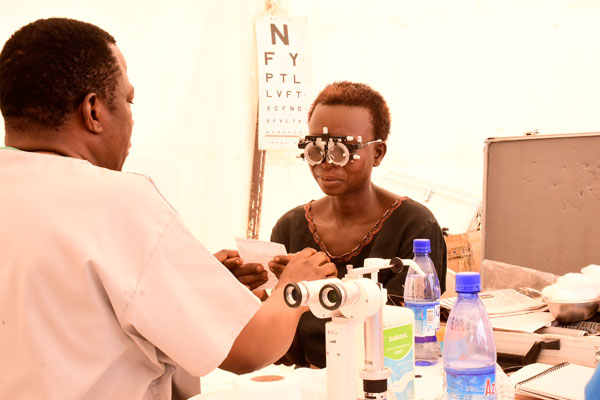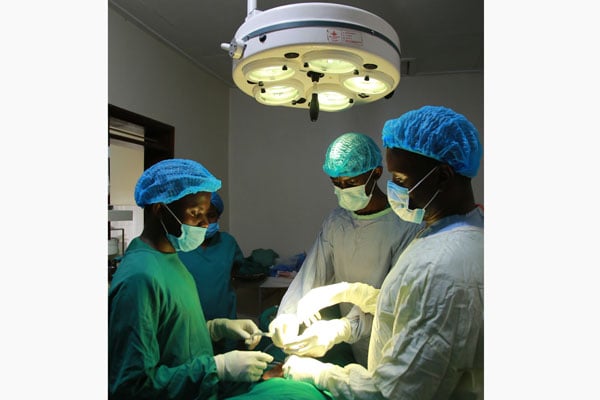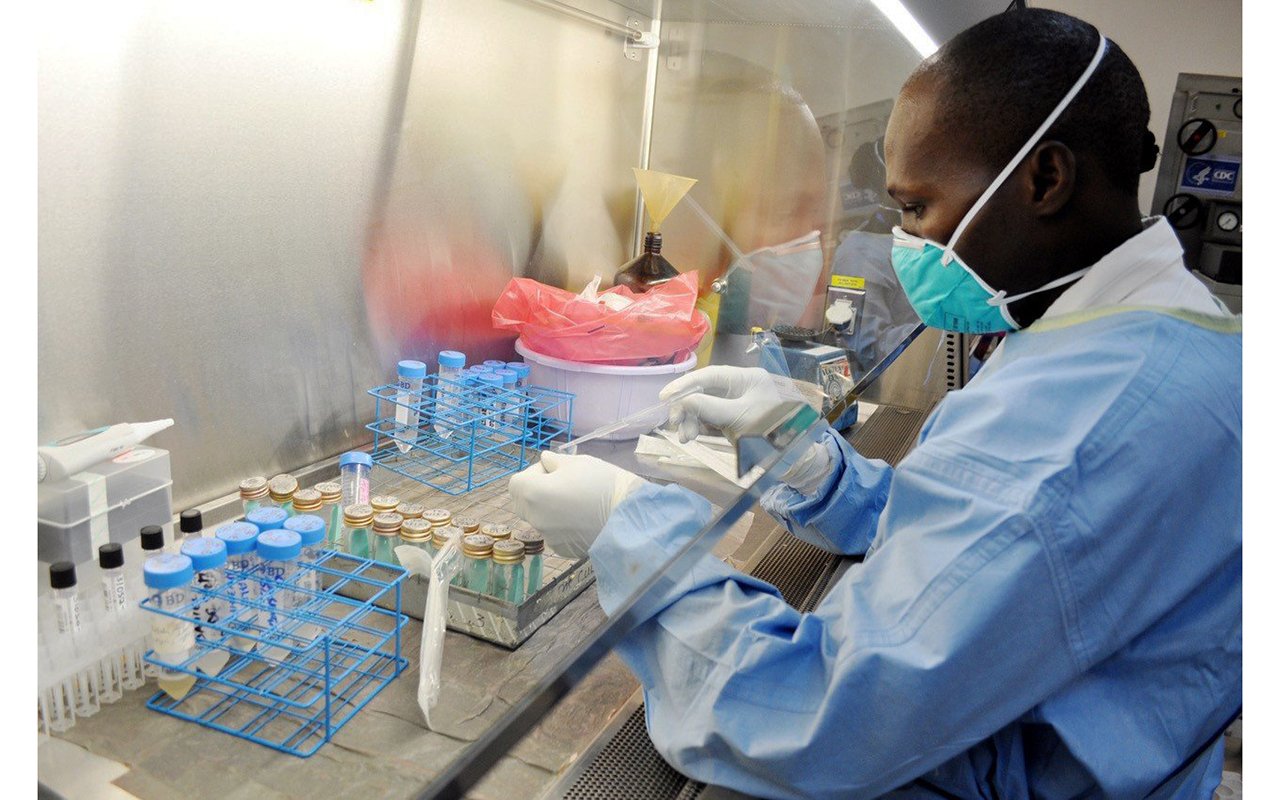Why Uganda has high blindness cases

An optician conducts an eye test on a patient during a health camp at Victorious Primary School, in Mengo, Kampala in 2019. PHOTOs | RACHEL MABALA
What you need to know:
- The retired medical worker revealed to this reporter that his wife (unnamed) was also operated last month because of cataracts and glaucoma.
Paul Odongo, 70, a resident of Apac District, is receiving medical care after his left eye was operated last week at Mengo Hospital in Kampala.
He says the operation followed a shocking loss of sight after a painless disease attacked his eyes.
“Five years ago, I started experiencing strange changes in my eyes. Every day I looked at my face in the mirror, my left eye was narrowing. But there was no pain in the eye,” he recalls.
Odongo, a retired pharmacist, says he later felt his sight was getting blur.
“So, I went to Apac hospital and the doctor who examined my eyes said there was some disease in my eyes. But he couldn’t tell me what exactly it was because he was not an optician,” he says.
However, Odongo didn’t know the disease was spreading so fast and soon, he couldn’t do basic things he enjoys such as reading.
He was brought to Mengo hospital for specialised care and upon examination, doctors found that he had cataracts which had affected both eyes.
“Last week, the left eye was operated and the doctors told me to come back after one year for the right eye to be operated. The operation cost me Shs1.2 m,” Odongo reveals.
He adds: “Right now, I can see well but I am still getting medication before I return home. I miss reading my Bible.”
The retired medical worker revealed to this reporter that his wife (unnamed) was also operated last month because of cataracts and glaucoma.
However, the couple is not the only ones affected by eye problems.
Ms Benina Kaggwa, 87, a resident of Kampala, was on Good Friday discharged from Mengo hospital.
Just like Odongo, Ms Kaggwa was also diagnosed with cataracts after losing her sight.
“I started having problems with my sight 20 years ago. Every time I went to the hospital, they would ask me to wait. However, last year, the doctor informed me that I could be operated,” she says.
Ms Kaggwa, who was operated on Wednesday, reveals that although she is experiencing some pain she is able to see with the left eye.
Cataracts affected both of her eyes. “They told me to come back after some months to operate the right eye. The price of operation is a bit high,” she says.
The burden
Mr Odongo and Ms Kaggwa make part of the rising cases of avoidable blindness and visual impairment among Ugandans.
Dr Lisbon Aliraki, the head of the eye department at Mengo Hospital, one of the major eye care centres in the country, says the number of people experiencing eye problems has almost doubled.
“We used to see around 260 patients presenting with eye problem per day. But these days we receive 400 patients in a day,” he reveals.
Dr Aliraki says 57 per cent of blindness cases in the country are caused by cataracts and that uncorrected refractive errors are the commonest cause of visual impairment.
The hospital performs around 3,000 eye surgeries per year and receives at least 60,000 patients annually, according to information from management.
However, eye specialists say there is no recent study conducted in the country to determine the rate at which the burden of eye problems is rising in the country.
But previous figures from the government’s Health Management Information System indicate that between 300,000 and 350,000 people in Uganda are blind, and more than 1.2 million have visual impairment
The country is a signatory to the World Health Organisation strategy for elimination of avoidable blindness by the year 2020.
About cataracts
Dr Dan Bwonya, another eye specialist at Mengo Hospital, attributes the rising cases of eye problems to the increasing burden of lifestyle diseases such as diabetes, rising population and improvement in lifespan.
“Cataracts is the leading cause of blindness worldwide and age is the leading factor. When you turn 60 years, your eye lens starts becoming opaque and gradually worsens as you grow older and soon, your vision fails,” he says.
The eye lens serves as the centre of eyesight by controlling the light entering the eye.
He defines cataract as a cloudy area in the lens of the eye that leads to a decrease in vision.
Dr Bwonya says symptoms of cataracts include faded colours, blurry or double vision, trouble with bright lights, and trouble seeing at night.
“Injuries are the other cause of cataracts. When something hits your eye, you can end up developing cataracts. It can also be a result of other diseases like diabetes, which affect eye lens by disorganising nerves in the eye,” he explains.
The expert reveals that people who work in places where there is intense heat such as pottery are at higher risk of developing cataracts.
“Then there are cataracts which develop in children who have illnesses before birth. This can be caused by infections within the uterus, and some medications being used by the mother can also affect the baby and cause cataracts,” Dr Bwonya says.

Surgeons conduct an eye operation at a hospital in Kampala.
Prevention
Dr Bwonya says there is still no medicine that stops cataracts that have started developing.
“So, the only treatment available is that when the lens is too opaque that your eye can no longer see, we remove it and insert an artificial one which is clearer,” he says.
Dr Bwonya urges people to avoid lifestyles that increase the risk of developing diabetes, a major contributing factor in cataracts.
The risk factors for getting diabetes include being overweight which can result from lack of physical exercise, and eating foods with high sugar and fat levels, according to information from www.medicne.net.com. Other factors include a family history of diabetes.
Health minister Dr Jane Ruth Aceng urges the public to go for regular eye checkups and eat balanced diets, fruits and vegetables rich in vitamins to boost their optical health.
“When you clock 40, you should frequent eye care centres to avert sight loss. Up to 75 per cent of blindness is avoidable,” Dr Aliraki .
Other causes of eye problems
Minister Aceng says common causes of eye diseases include glaucoma, trachoma and refractory errors.
Dr Bwonya explains that glaucoma is the condition where the pressure in the eye rises above the normal range, but that this can be stopped when detected early.
He says the eye operates well at the pressure levels of 10-21 millimetre.
“But, failures in the functioning of the system in the eye to efficiently produce and drain the normal liquid called aqueous, which is in the eye, and diseases like diabetes, can cause the rise in pressure levels, hence glaucoma,” he says.
The expert explains that glaucoma causes blindness by destroying the nerves in the eyes that control sight.
“When the pressure has damaged the nerve, it cannot be reversed, but when we detect the rising pressure in the eye before the damages, we can reverse this. It can be reversed through medication to stop the pressure or surgical operations to correct the drainage of the aqueous liquid in the eye,” Dr Bwonya says.
He also explains that refractive error means that the shape of one’s eye does not bend light correctly, resulting in a blurred image.
He says the problem manifests as shortsightedness and long sightedness and that this is majorly caused by hereditary factors such as family history of such conditions.
Dr Bwonya says trachoma, a major cause of blindness and visual impairment in the country, is a contagious bacterial infection that affects the surface of the eyes.
The bacteria cause inflammations in the eye which heal leaving scars or ulcers in the eye that can lead to blindness.
Dr Aceng says people should take personal responsibility to protect their eyes and visit hospitals regularly.
“People should always read in good light, as well as avoid self-medication. You should wash the face around the eyes every morning and protect the eyes from direct sunlight,” she said.
Key challenges
Dr Rose Mutumba, the director of Mengo hospital, says Uganda faces severe shortage of human resources and infrastructure to handle the rising burden of eye problems.
A 2020 report by eye specialists; Dr Joseph Magyezi from Ruharo Eye Centre, Ruharo Mission Hospital, Mbarara and Dr Simon Arunga from Mbarara University of Science and Technology, indicated that there is need for urgent action to improve quality and accessibility to eye care.
“Uganda’s population of 40 million is served by just 40 ophthalmologists (1 per million population), and half of them work in the capital city, Kampala. This means that the majority of eye care services in the country are provided by non-ophthalmologists,” their report reads.
It is titled Eye care where there are no ophthalmologists: the Uganda experience.’
About vision impairment
The most common forms of vision impairment are errors of refraction -- the way light rays are focused inside the eye so images can be transmitted to the brain.
Nearsightedness (myopia), farsightedness (hyperopia), and astigmatism are examples of refractive disorders and often occur when the eyes are otherwise healthy.
Refractive errors are correctable usually with glasses, contact lenses, or refractive surgery, such as LASIK.




